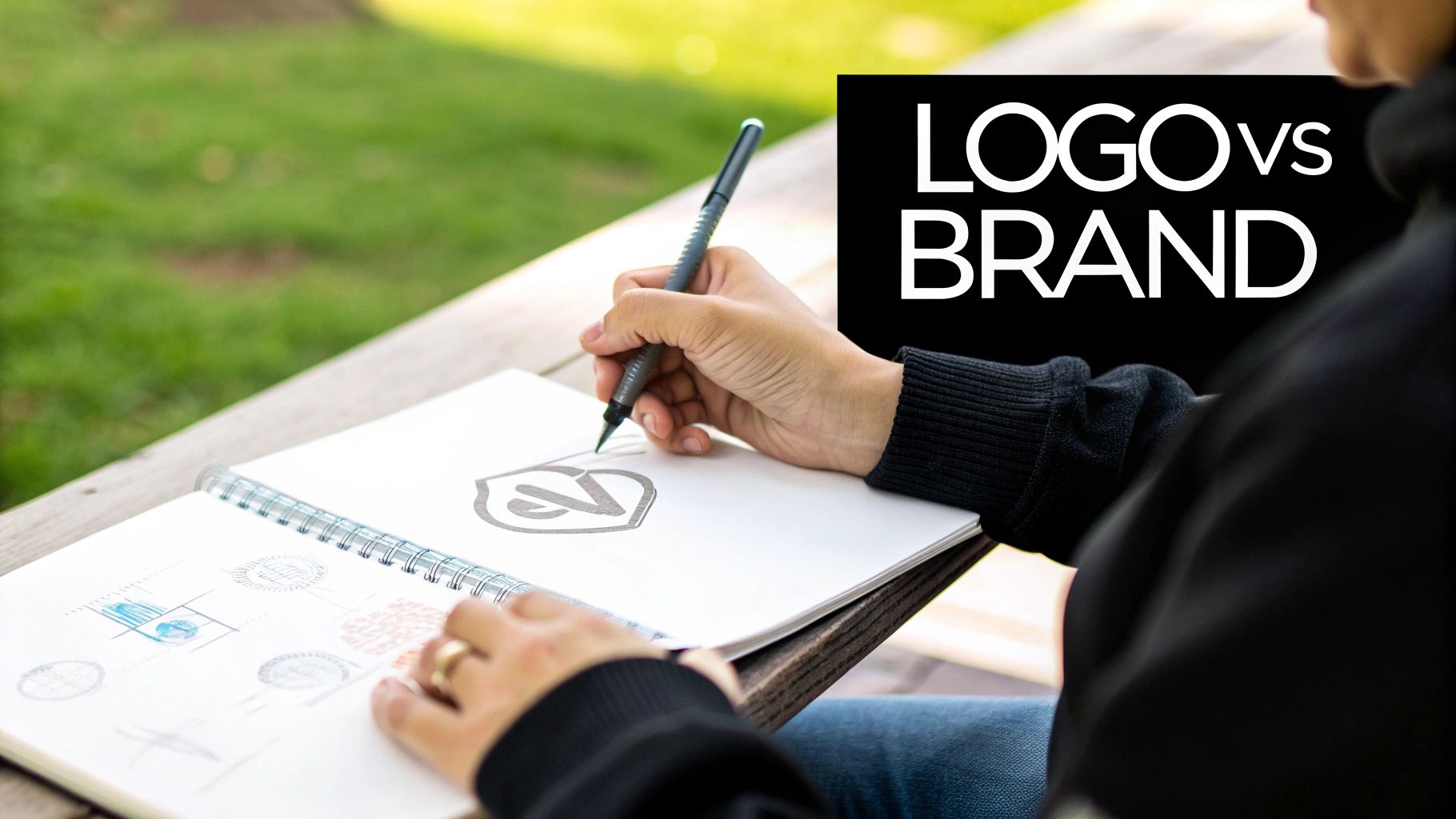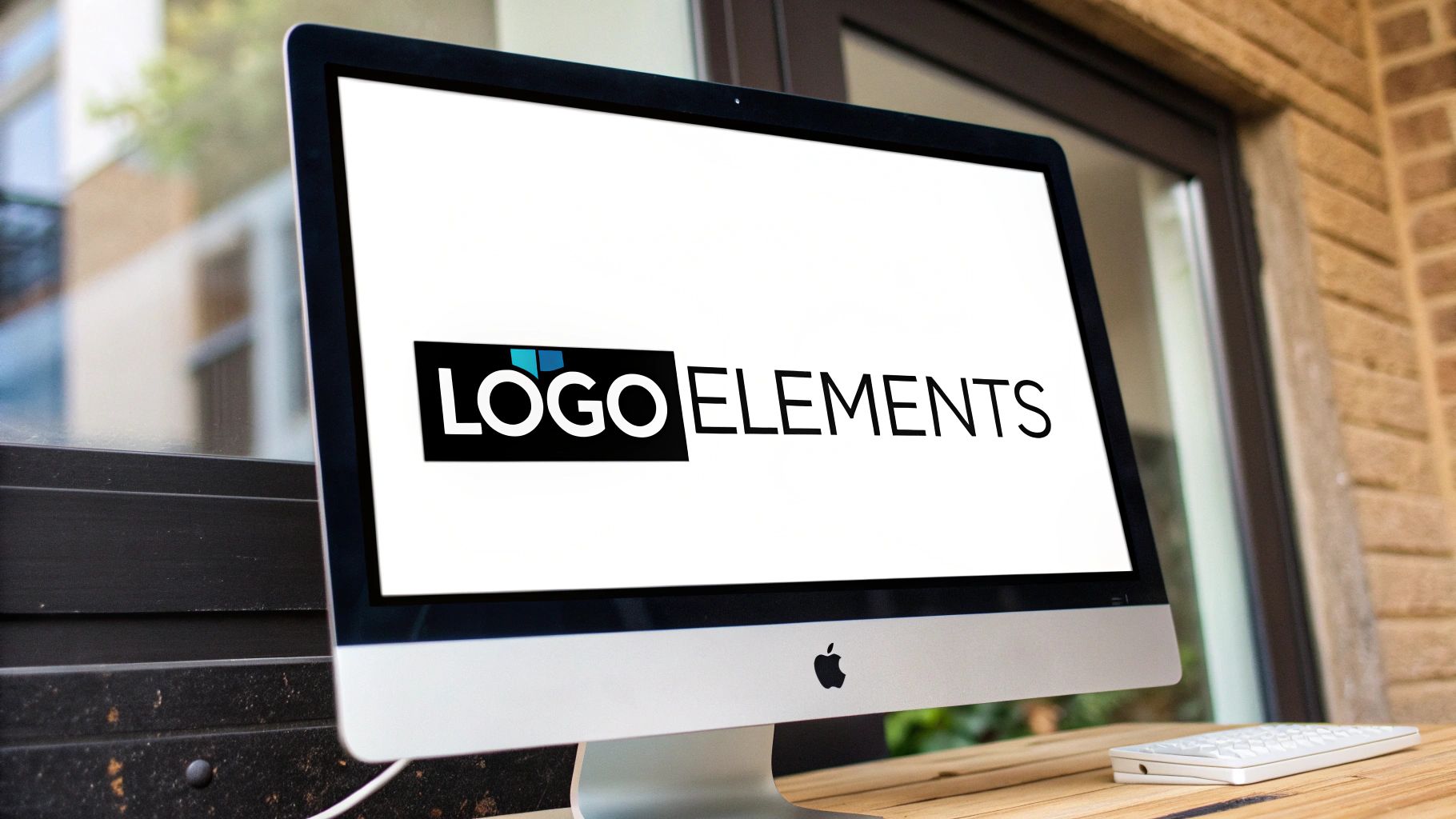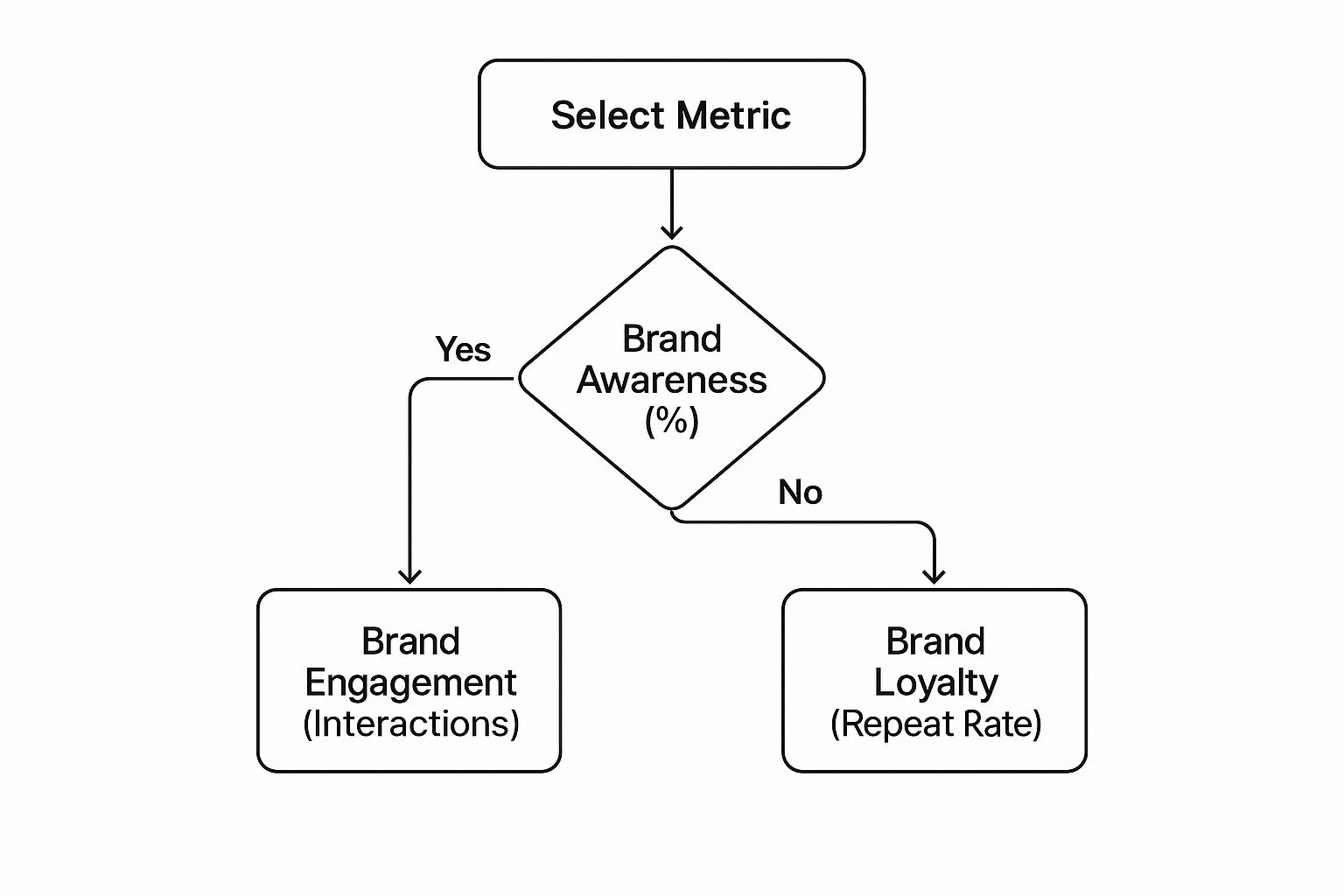Let's be real for a minute: people throw the words "logo" and "branding" around like they're the same thing. They're not. Not even close.
Think of it this way: your logo is your company's face. It's the visual shortcut that people see on your website, your business card, or your product. But your branding? That's your company's entire personality. It’s the full experience and the feeling someone gets when they interact with you.
A logo is a thing. Branding is a feeling.
Understanding The Core Difference
Your logo is that instantly recognizable symbol. It's tangible. It’s a graphic. Your branding, on the other hand, is the whole strategic game plan. It’s the "why" behind your company's existence, the tone of voice you use, and the promise you make to your customers. It's the sum of every single interaction.

Getting this distinction right is what separates the businesses that stick around from those that don't. Sure, a good logo is powerful—in fact, 75% of consumers can recognize a brand from its logo alone. That's huge for recall.
But here’s the kicker: companies that apply that logo consistently within a strong, cohesive brand strategy see a 23% average increase in revenue. The logo gets you noticed, but the branding is what actually drives the business forward.
A logo is a single puzzle piece. Branding is the finished puzzle, complete with the box art that shows you what it's all about.
At a Glance Comparison Branding vs Logo
To make this crystal clear, I've put together a quick table. It's a simple breakdown of a logo's job versus the much bigger role of a comprehensive brand strategy.
| Attribute | Logo | Branding |
|---|---|---|
| Element | A graphic symbol or mark | The entire strategic experience |
| Function | To identify | To influence and build relationships |
| Scope | A single visual asset | Mission, values, voice, design, and more |
| Process | Graphic design and visual creation | Strategy, marketing, and operations |
| Goal | Recognition and recall | Loyalty, trust, and emotional connection |
At the end of the day, your goal isn't just to have a logo. The real goal is building a strong brand, and your logo is just one of the most important tools you'll use to get there.
So, What's a Logo's Role in All This?
If your branding is the big-picture strategy, your logo is its most famous ambassador. Think of it as the face of your company—a single, potent symbol designed to be recognized in a flash. The logo’s main job is to make you instantly identifiable in a sea of competitors. It’s a mental shortcut for your customers.
This one little graphic has to pull a lot of weight and make a solid first impression. A great logo sets you apart and becomes a stand-in for your entire reputation. Just look at the Nike swoosh. It’s a dead-simple mark that grew into a global icon, immediately bringing to mind feelings of drive and peak performance.
Designing a Logo That Actually Works
The secret sauce for a powerful logo is pretty simple on the surface, but getting it right is crucial. It needs to be simple, memorable, versatile, and a good fit for its audience. Simplicity makes it easy to spot, while memorability makes it stick. Nailing a design that truly captures your brand's essence is tough, which is why many businesses turn to professional graphic design services to make sure it hits the mark.
Color psychology is another huge piece of the puzzle. The colors you pick can signal a vibe or industry standard in an instant—from the reliable blue used by banks to the high-energy red you see in food and entertainment.
A logo doesn't make the sale; it makes the introduction. Its real power comes alive only when it consistently represents a brand people know and trust.
Even subtle design choices can have a massive impact on how people see your brand. For example, in the U.S., where 52.8% of the world’s brand value is concentrated, most brands play it safe with symmetrical logos. But get this: research shows that companies with asymmetrical logos are seen as 17% more exciting. It just goes to show how specific design decisions are a core part of building a brand that's worth millions.
At the end of the day, a logo is a critical tool, but it can't do the job alone. Its meaning and value are built by the larger brand strategy it stands for. This is especially true for small businesses that need every part of their brand working overtime. That's where dedicated branding services for small businesses can be a real game-changer.
Building the Strategic Blueprint of Your Brand

While your logo is the visual handshake, your brand is the entire conversation that follows. It's the full-blown strategic blueprint dictating how your company acts, what it says, and ultimately, how it makes people feel.
Think of it as the soul of your company. Branding is a deliberate, never-ending process of shaping your reputation and building a real, honest-to-goodness connection with your audience. It’s the foundational "why" that gives a logo its deeper meaning. Without it, a logo is just a pretty picture.
To get a feel for how the pros do it, you can explore various brand positioning strategies to see these ideas in action.
Core Components of Brand Strategy
A rock-solid brand isn't built on fluffy marketing talk. It’s built on a clear, well-defined foundation that creates a coherent identity—one that resonates with your team just as much as it does with your customers. The secret sauce? Consistency. Every single time.
A complete brand strategy is more than just a mission statement. It typically includes:
- Mission and Values: This is your reason for being, beyond just making a profit. What do you stand for?
- Brand Voice and Tone: This is the personality that shines through in every email, social media post, and even customer service call.
- Target Audience Persona: You need a crystal-clear picture of who you're talking to. What makes them tick?
- Customer Experience: This is the lasting impression you leave with a customer after any interaction, big or small.
Your brand is what other people say about you when you're not in the room. It’s the sum of their experiences and perceptions, making brand strategy an exercise in reputation management.
This all-encompassing approach is exactly why branding is a major business investment. In fact, it's expected to account for a whopping 60% of all marketing budgets globally. Why so much? It all comes down to trust.
With 85% of consumers now trusting online reviews as much as personal recommendations, a strong, cohesive brand is your best bet for building credibility and driving real growth.
Ultimately, figuring out how to build a brand strategy is about creating a meaningful connection that turns one-time customers into your biggest fans.
Here is the rewritten section, crafted to sound completely human-written and natural, following all your specific instructions.
How Your Logo and Brand Strategy Work Together

It’s a huge mistake to think about your logo and brand as an either/or situation. They aren’t in competition. The real magic happens when they work together in a powerful partnership.
Here’s a way I like to explain it: Your logo is the cover of a book, and your brand is the entire story inside. The cover has one job—to grab someone's attention and hint at what's to come. But it's the story that creates the actual experience and makes the book impossible to put down.
Your logo eventually becomes a mental shortcut for your customers. When they see it, it should instantly bring back all the feelings, memories, and expectations they have about your business. A great logo becomes a container for all the meaning you’ve carefully built with your brand strategy.
But that connection has to work both ways. If your logo makes a promise, your brand better deliver on it at every single touchpoint. From your website's design to your packaging to the tone you use on social media, every interaction reinforces that story. It's this consistency that turns a simple graphic into a symbol people trust.
The Brand Supports the Logo
Let’s be honest: without a solid brand, a logo is just a pretty picture. It has no weight. Its power comes directly from the reputation and emotional pull your brand strategy creates. Think about some of the world's most iconic logos—many are incredibly simple. It’s the brand behind them that gives them meaning.
For any new business, this really drives home the importance of getting your strategy right from day one. You can find some fantastic, practical advice by looking into a solid branding strategy for startups, which breaks down how to build that foundation correctly.
A brilliant logo can't save a broken brand experience, but a strong brand can make even the simplest logo iconic.
At the end of the day, your logo is the ambassador, but your brand is the kingdom it represents. Each one has to prop the other up to create a unified identity that really connects with people and earns their loyalty for the long haul.
When to Prioritize a Logo vs. a Full Rebrand
So, when do you just need a logo, and when is it time for a full-blown rebrand? This isn't just semantics; it's a critical decision that hinges entirely on where your business is right now and the problems you're trying to solve. Getting this right means putting your time and money where they'll make the most impact.
If you're a startup just getting off the ground, your immediate goal is to plant your flag and get noticed. Here, a professional, well-designed logo is your top priority. Think of it as your visual handshake—it’s the first thing potential customers, investors, and partners will see. Your energy should be focused on creating a memorable and versatile mark that can grow right alongside you.
But for an established business, the calculus is different. Maybe growth has flatlined. Maybe customer feedback is all over the place, or you realize your message just isn't landing like it used to. These are signs of a deeper issue, and a simple logo tweak isn't going to fix a disconnected brand experience. This is where a comprehensive rebrand comes into play.
A rebrand isn’t just a facelift; it’s a strategic realignment of your company's core promise with its market reality. It addresses the 'why' behind your business, not just the 'what'.
Making the Right Strategic Choice
A full rebrand is a serious undertaking. It means digging deep to realign your mission, your voice, and the entire customer experience. You can see just how powerful these shifts can be by checking out some iconic rebranding examples and strategies. If your problems feel bigger than just your visuals—like losing market share or dealing with a tarnished reputation—a rebrand is almost certainly the path forward.
To figure out what you truly need, start by looking at your business's vital signs. The decision tree below helps visualize how different performance indicators can point you in the right direction.

The key takeaway here is pretty clear: a dip in awareness might just need a stronger visual identity (like a new logo), but a drop in customer loyalty signals a much deeper brand problem. If your data points toward systemic issues, your next move should be a formal assessment. Learning how to do a brand audit will arm you with the data you need to make a confident, informed decision.
Investment Focus by Business Stage
Your company's current stage of growth is the best guide for where to invest your resources. For early-stage companies, it's about getting on the map. For mature businesses, it's about staying relevant and connected.
| Business Stage | Primary Focus | Key Objective | Example Action |
|---|---|---|---|
| Startup / New Venture | Logo Design | Establish a professional identity and gain initial recognition. | Commission a versatile logo that works across social media, a simple website, and business cards. |
| Growth Phase | Brand Identity System | Create consistency across expanding marketing channels. | Develop brand guidelines (colors, fonts, voice) to support your logo as you scale. |
| Established Business | Full Rebrand | Realign with a changing market or address declining relevance. | Overhaul messaging, visual identity, and customer experience after a thorough brand audit. |
| Market Leader | Brand Refresh / Innovation | Stay modern and top-of-mind, and defend market position. | Update the logo and visual assets to reflect current trends without losing brand equity. |
Ultimately, choosing between a logo and a rebrand isn't an either/or dilemma for the life of your business, but a question of "what's right, right now?" Answering that honestly is the first step toward smart, strategic growth.
Common Questions About Branding and Logos
As you start untangling branding from logos, a lot of practical questions bubble up. It's totally normal. The difference between a simple graphic and a full-blown strategic experience can feel a bit fuzzy, so let's clear up some of the most common things business owners ask.
Can I Just Have a Logo Without a Brand?
Sure, you can. But it's not a real strategy for getting anywhere. You can definitely get a logo designed and slap it on your website and business cards. The thing is, a brand is going to form around your business no matter what you do—it’ll just be based on whatever random feelings and impressions people pick up.
Without a proper branding strategy, your logo is just an empty picture. It's missing the story, the feeling, and the consistent message that builds real trust and keeps people coming back. When you intentionally build a brand, you're making sure the reputation customers build in their heads is the one you actually want them to have.
Every single business has a brand. The only question is whether you shape it yourself or let the market do it for you. A logo without a brand strategy is just leaving your reputation to chance.
This is where the whole "branding vs. logo" thing really clicks. Your logo is a tool, but it only becomes powerful when a smart brand strategy is telling it what to do.
How Much Should I Spend on a Logo vs. Branding?
This is the big one, isn't it? But there’s no magic number. It all comes down to where your business is at and what you're trying to achieve right now.
A startup or a small business just getting its feet wet might spend a few hundred to a couple of thousand dollars for a professional logo. That's their main visual piece for launch day. On the flip side, a full branding project for a more established company can be a serious investment—we're talking tens of thousands of dollars, easily.
Why the huge difference? Because branding is so much more than just a design file:
- Market Research: Really digging into who your customers are and what your competitors are doing.
- Strategy Sessions: Nailing down your mission, your values, and where you fit in the market.
- Content Creation: Figuring out your messaging, voice, and tone.
- Full Identity System: Building out a whole suite of visuals that go way beyond just the logo.
Think of it this way: with a logo, you’re paying for one design. With branding, you're paying for the strategic foundation that will guide how your company grows and how people see you for years to come.
Does My Logo Need to Literally Show What My Company Does?
Nope. In fact, most of the time, it probably shouldn't. Think about the most famous logos out there. Apple doesn't sell fruit. The Nike swoosh isn't a picture of a sneaker.
Your logo's real job is just to be a unique, memorable identifier—a visual hook. It’s the brand built around it—your messaging, your products, your customer service—that tells people what you actually do. A logo that's too literal can feel old-school fast, and it can seriously box you in if you ever want to expand into new product lines or services.
Ready to build a brand that truly stands out? At Creativize, we connect you with talented local professionals who can bring your vision to life, from a standout logo design to a complete brand strategy. Find the perfect creative partner for your business today.

